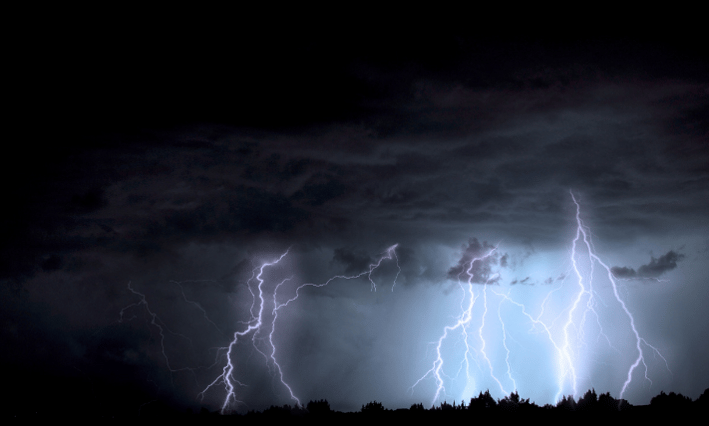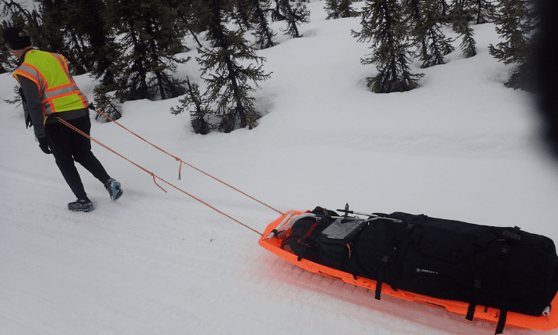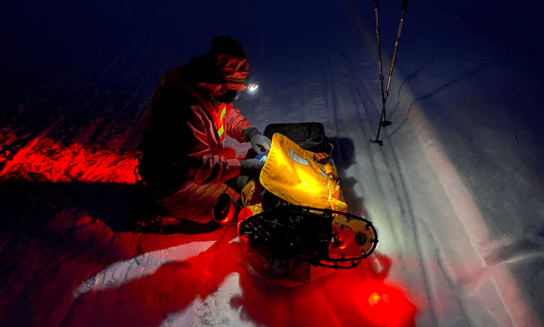Posted by Weatherflow ● January, 2022
Tempest News | January 2022

WHAT TRIGGERS LIGHTNING?
It’s the most energetic process on the planet. Many superstitions, stories, religions, and ideas have centered around the bright and powerful lightning strike, electrifying the sky or dramatically touching down. Now, detailed footage from a network of small, low-frequency radios has allowed researchers to model a lightning bolt's first sparks.
WEATHER AND CLIMATE NEWS in REVIEW
2021 was a year for the record books in many ways, but especially when it comes to extreme weather events. It was also a big year for climate conferences and weather-related action in governments worldwide. Look back at ten major weather stories of 2021 from the United States and beyond.
OVER 40% OF AMERICANS LIVE IN AREAS HIT BY WEATHER DISASTERS LAST YEAR
According to an analysis of federal disaster declarations, more than 4 out of 10 Americans live in counties that were struck by climate-related extreme weather in 2021, and over 80% experienced heatwaves. The Federal Emergency Management Agency declared eight statewide emergencies (the most since 1998), and the destruction overall cost over $104 billion in addition to the loss of hundreds of lives amidst devastating wildfires, floods, severe storms, and more.
Recognized as one of the toughest races in the world, the Arrowhead Winter Ultra Race takes place every year in January in International Falls, Minnesota over three bitterly cold days. For this year's race, which kicks off on January 31, nearly 200 people are signed up to run, bike, or ski the 135-mile course. Winning runners typically finish Arrowhead in 36-48 hours, and almost half the racers drop out.
Tempest tracked down two racers, Bonnie Busch and Rachel Utecht to hear more about their motivation for undertaking such an extreme winter challenge. First up, Bonnie Busch:

Q: HOW MANY TIMES HAVE YOU DONE THE RACE?
A: Seven times with three finishes. The goal is to finish. I have always been on foot. Running is a strong word for what everybody is doing - there is not much running. It’s more like a slow walk or trot. I try to average about 3 miles an hour.
Q: TELL ME ABOUT THE COURSE AND HOW YOU PREPARE FOR THE COLD?
A: It’s 135 miles from International Falls to Fortune Bay. The terrain starts off fairly flat. After 30 miles, it starts to go up and down, up and down. Then, just before 72 miles, you have to go across the lake, which is frozen.
Q: HOW DO YOU PACK FOR SOMETHING LIKE THIS?
A: I didn’t finish my first year. I made it 50 miles but didn’t have the knowledge to understand what I needed to do. My sled was overpacked and far too heavy that year, which slowed me down. I had good equipment but I had to learn what not to pack. Every time you put something on the sled, you have to think, ‘how will I use this?’ Food is heavy. Water is really heavy. A thermos weighs a few pounds. You need headlamps and food and you have to carry a stove in case you have to melt snow for water. It was also extremely windy and negative 35° degrees, and I just wasn’t prepared.
Q: TELL ME MORE ABOUT PLANNING FOR THE WEATHER.
A: I typically only start looking at weather about a week leading up to the race, but that will be it. I always have to be prepared for things to change, including the forecast.
Q: WHAT TYPE OF WEATHER DO YOU PREPARE FOR?
A: It can be anywhere from 30 degrees above zero to negative 30-40 degrees. I don’t have the inclination for the really cold stuff. I don’t have the gear for it either. My preference is for temps in the negative 10 to 20-degree range. There’s more bite to the snow, less moisture and I can get a good grip on it.
Q: DID YOU HAVE THE IDEAL WEATHER FOR THE 3 RACES YOU FINISHED?
A: Yes, the 3 finishes temperature was in those ranges (negative 10° to 20°). Once you get below -35° (and that doesn’t include the wind!) that’s dangerous for me. I can handle some of it and I’ve got better clothes and gear, but it can be really frightening. There are things that change so dramatically. Frostbite is a really big deal. I’ve seen way more of that than I care to see.
Q: HOW DO YOU AVOID FROSTBITE WHEN IT'S MORE THAN 30 DEGREES BELOW ZERO?
A: It’s hard. You still have to eat and drink fluids, and do all these things. You have to find ways to cover your face and nose and ears, the smallest things can be so problematic.
Q: HOW LONG WILL IT TAKE YOU? AND WHEN DO YOU SLEEP?
A: Sleep? A lot of people don’t. Some of these guys do this in a day and a half. In 2019, the women’s winner finished in 44 hours and 40 minutes. My times are in the 55-hour category. I don’t sleep on the trail because I will lose four hours (unpacking and packing up) to get 2 hours of sleep. I have done it, but it’s not a great idea. Your decision-making skills go south. One thing I like to do is take short naps. I sit on my sled and on a sunny afternoon out of the wind. Ten minutes on a sled with your eyes closed can feel wonderful.
Q: HOW DID YOU GET INTO ULTRA RACING?
A: I wouldn’t necessarily call myself an athlete. I picked up running after college, but it didn’t take me long to get bored with local 5k, 10k, and ½ marathons. A local running club introduced me to ultra running and I fell in love. I found everyone was willing to go at my pace — comfortably slow. I started back in the late ’80s and have been doing it ever since.
Q: I GUESS MY LAST QUESTION IS WHY DO YOU DO IT?!
A: It’s just you against the weather and the elements. And it is BEAUTIFUL! It’s quiet, you’re in the middle of a winter landscape, you hear wolves at night. You see footprints from moose. Last weekend, a guy ran into a porcupine on the trail. I’m not a risk-taker (they scare the heck out of me!) and for the most part, the racers are not either. It’s people happy to be outside, willing to do the training, and ready to enjoy the great outdoors.
Next up, Rachel Utecht:

Q: Hi Rachel. Where are you based?
A: I’m in Fargo, North Dakota. It’s about 5-6 hours away from International Falls. Today it’s 15 below zero in Fargo!
Q: HOW MANY TIMES HAVE YOU DONE THE RACE?
A: This will be my 7th year out there. In my first two attempts, I didn’t finish. In my first year, it snowed a foot. Less than a handful of people finished that year on foot and I was not one of them!
The second attempt was the polar vortex year (2018). I made it halfway that year, but it was wicked cold. The batteries in my headlamps froze. My water froze! I camped out at night to wait for daylight so I’d have light again.
Q: HOW COLD DID IT GET?
A: It was close to 50 or 60 degrees below zero with the windchill. Part of our gear requirement is that we have Everest-rated equipment. So my sleeping bag is rated to -20°.
Q: SO WHAT IS THE UPSIDE OF DOING THIS?
A: It’s incredibly silent. There's a stillness to winter that you can’t beat. It’s like living inside a snow globe. Everything sparkles when it gets to subzero temperatures. It’s kind of enchanting that way.
Q: MY QUESTION IS WHY NOT JUST GO FOR A NICE LONG WINTER HIKE? WHY 135 MILES?
A: I have always loved winter. Winter is a lot of our year in the Midwest, so if you’re going to live here, you should learn to do things that make you love winter. Otherwise, you will hate it.
Q: HOW LONG HAVE YOU BEEN DOING ULTRA RACING?
A: I’ve done 10 years of ultra racing. I own two businesses. One is a farm-to-bottle hot sauce company, and my busy time is summer through fall. Most of these types of endurance races happen in summer. But I love to cover distance and love winter. It's a natural selection sort of thing! I don’t race most of the year, just in winter.
Q: BECAUSE OF THE WEATHER, IS PREPARATION THE MOST IMPORTANT PART OF THE RACE?
A: The most important thing about the race is you can have top-level gear, but if your mind is not in it, it doesn’t matter. A lot is preparing for the fact that you’ll be uncomfortable to some degree, and just accepting that. That’s endurance racing in general. You’ll be uncomfortable.

Q: DO YOU SLEEP?
A: I definitely sleep. You’ve got three checkpoints and snowmobiles keep track of you, to be sure no one is getting hypothermic. At the checkpoints, you can warm up, change layers, shoes and socks if you want to. At the midway point, you can sleep there. The checkpoint is a resort on a lake around 72 miles. You cross the lake and there’s a group cabin, where you can grab a little sleep or you can rent a cabin. A lot of bike racers rent and make a fun weekend out of it. If your goal is not to be the fastest, you can grab a burger at the resort. But when you’re on foot you have to be diligent on time because it’s a lot of distance to cover dragging equipment behind you. I usually only sleep for 45 minutes to an hour at the midway point.
Q: HOW CAN YOU KEEP GOING FOR SO MANY DAYS DOING SOMETHING SO PHYSICALLY EXHAUSTING WITHOUT SLEEP?
A: You learn how to function in zombie mode. Things get pretty simple when you’re tired - it’s about keeping warm and not getting frostbite. Also, I have two full-time jobs. I work as an interior designer by day and run a craft soda business, Flannel Fizz, and the hot sauce company Off the Deck Hot Sauce. It’s good fatigue training! I joke with everyone that I’m used to being tired. That part I’ve got down.
Q: WHEN DO YOU TRAIN?
A: I train for the races on Saturday. Some days, I run to and from work which is 8 miles total. Plus I’m on my feet all day. And on the weekend, I’ll do a 20-30 mile run. A lot of it’s your mind. You can be the fittest athlete but can’t do these things if your mind can’t take it.
Q: TELL ME ABOUT A HIGH YOU'VE EXPERIENCED DOING THE ARROWHEAD 135?
A: I was one of the first women to do the race completely unsupported on foot. This means that what I started with is what I finished with. I didn’t use checkpoints. I boiled snow for water. I carried all my food. I did nothing indoors at all.
You are completely out there by yourself. And one highlight during that race was sunrise on the third day. I stopped to sleep in my expedition bag. I was boiling snow to make more water to fill my thermos. I had an awesome moment sitting in my sleeping bag, the snow was glittering, there was a pink sky, it was 10 degrees below zero. I was sitting there drinking hot chocolate with coffee in it. It was bitterly cold but there was a clarity to it. And it was the ultimate quiet!
Q: WHAT WOULD YOU WANT SOMEONE TO KNOW ABOUT THE EXPERIENCE?
A: It’s empowering to do these things. I know I can survive outdoors in subzero temps with only what I’m carrying and enjoy it. It makes a lot of things less scary. Also, what people should know is to think about this race as a walkabout for most of us. This is a time where we get recharged and refreshed on a retreat level. It’s physically refreshing in a way like having a hard workout can revive you. It’s not a miserable experience. It’s actually pretty enjoyable.
You can learn more about the Arrowhead 135 by visiting their website at http://www.arrowheadultra.com/.
Back to: Newsletter

